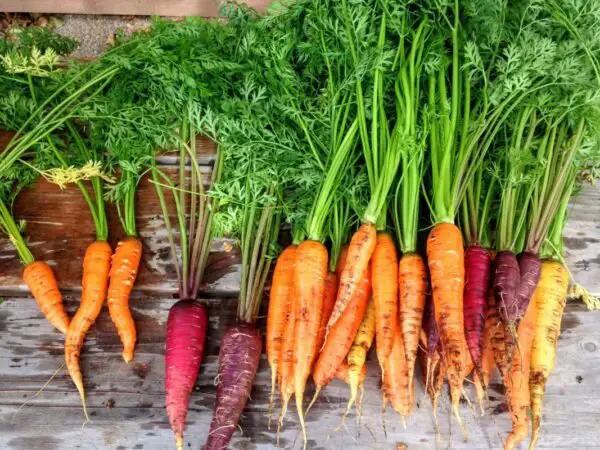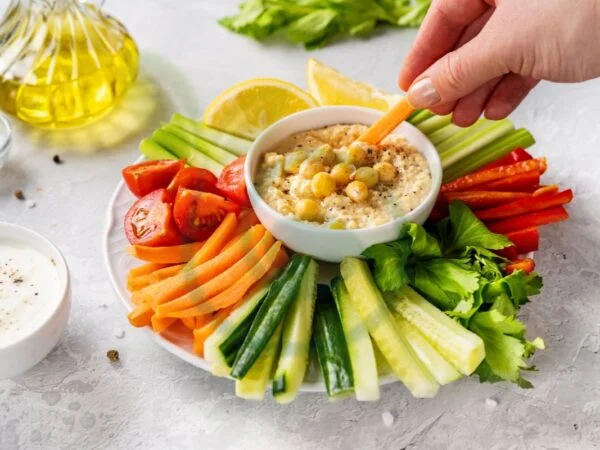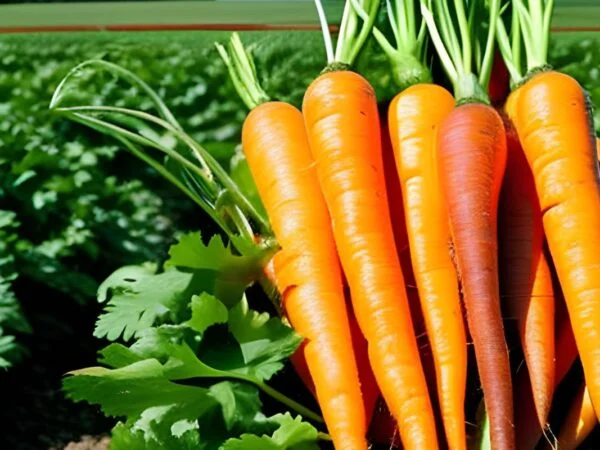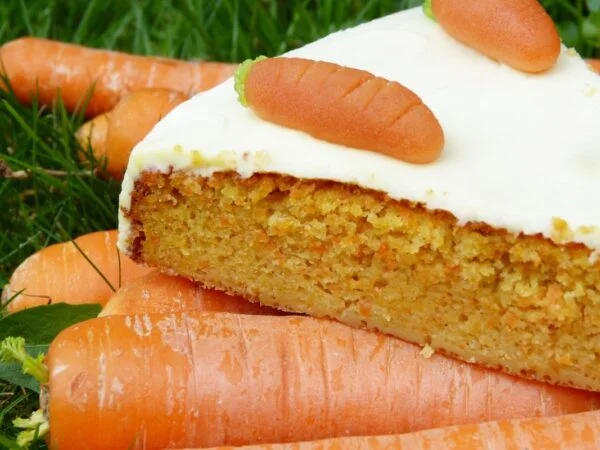Looking to plant root veggies like carrots but don't have a large garden space? No worries! Container gardening is the solution you've been searching for. With limited space, it may seem challenging to cultivate your own root veggies, but growing carrots in containers is an increasingly popular choice among urban gardeners. Carrots are a great crop to plant and grow from seed.
Carrots are a great vegetable plant for container cultivation because of their deep root system. The seeds can be planted in ground beds. By using containers, you can provide the necessary depth for the vegetable roots to thrive and produce healthy, flavorful carrots right at home.
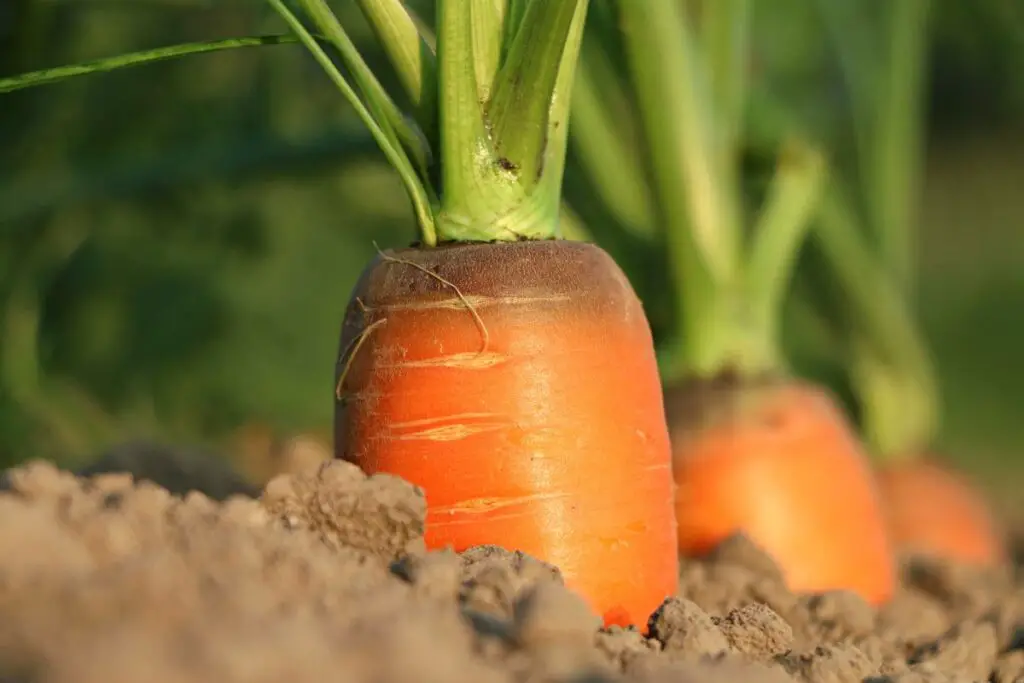
The containers should be at least 12 inches deep. Whether you have a small balcony or a tiny backyard, container-grown root veggies like carrots offer convenience and accessibility for home gardeners of all levels. Planting these vegetables in containers allows you to easily grow them in limited spaces
You'll discover valuable tips on selecting the right container for growing root veggies, preparing the soil for round and long carrots, sowing seeds or transplanting seedlings of various carrot varieties, and providing proper care for both the roots and carrot tops throughout their growth journey. Get ready to enjoy the satisfaction of harvesting your very own homegrown root veggies without needing vast expanses of land. Plant and grow carrots in your garden.
Benefits and Advantages of Container Carrot Cultivation
Container gardening, especially for plants like long carrots, has gained popularity among both seasoned gardeners and beginners alike. Opting for container cultivation offers several benefits and advantages, such as protection against carrot fly, that can enhance your gardening experience. Let's explore why growing carrots in containers is a practical choice.
Better Control Over Soil Quality, Moisture, and Temperature
One of the significant advantages of container carrot cultivation is the ability to have precise control over crucial factors such as soil quality, moisture levels, and temperature. Unlike traditional ground planting, where you have limited influence over these elements, containers allow you to tailor them according to your carrot plants' specific needs.
By selecting high-quality potting soil enriched with organic matter, you can ensure optimal nutrition for your carrots. Containers provide excellent drainage properties that prevent waterlogging, allowing the roots of carrot plants to thrive without the risk of rotting caused by carrot fly. You can also monitor and adjust the moisture levels easily by watering directly into the container or using self-watering systems to prevent carrot fly.
Furthermore, containers offer better insulation against extreme temperatures compared to open ground gardens. This advantage becomes particularly useful during colder seasons when carrots require a stable environment for healthy growth. With containers, you can move them indoors or place them strategically on sunny spots during winter months to protect your crop from frost damage.
Reduced Risk of Soil-Borne Diseases and Pests
Another notable benefit of container gardening for carrots is the reduced risk of soil-borne diseases and pests. Growing carrots in containers minimizes contact with contaminated soil that might harbor pathogens or harmful organisms detrimental to their growth.
Containers provide a physical barrier between your plants and potential threats lurking in the ground. This advantage significantly decreases the chances of diseases like root rot or nematode infestations affecting your carrot crop. Pests such as carrot flies are less likely to target container-grown carrots since they typically rely on detecting scents emitted by plants rooted in open soil.
Easy Mobility and Flexibility
Container gardening offers unparalleled mobility and flexibility. Unlike traditional gardens, where plants are rooted in one spot, containers allow you to move your carrot crop as needed. This advantage is particularly useful for gardeners with limited space or those who wish to optimize sunlight exposure throughout the day.
You can effortlessly relocate your containers to take advantage of the sun's movement or protect your carrots from excessive heat during scorching summer days. Moreover, this flexibility enables you to bring your carrots indoors during inclement weather or when frost threatens their well-being.
Weed Control Made Easier
Weeds competing with your carrot plants can hinder their growth and steal valuable nutrients from the soil. However, container cultivation significantly reduces the risk of weeds invading your crop.
By using clean potting soil free from weed seeds, you start with a clean slate that minimizes weed presence right from the beginning. The controlled environment of containers makes it easier to spot and remove any unwanted intruders promptly.
Selecting the right carrot variety for successful container gardening
Selecting the right carrot variety is crucial for a successful harvest. With many types of carrot varieties available, it's important to choose ones that are suitable for container gardening. Here are some key points to consider when selecting the perfect carrot variety:
- Choose shorter varieties like 'Thumbelina' or 'Paris Market' that are ideal for containers. These compact varieties have shorter roots and do not require as much depth as traditional carrot varieties. Their small size makes them well-suited for growing in confined spaces such as pots or raised beds.
- Look for compact varieties that have strong disease resistance traits. Container-grown carrots are more susceptible to diseases due to limited soil volume and potential moisture issues. Choosing carrot varieties with built-in disease resistance can help ensure a healthy crop. Some popular disease-resistant options include 'Napoli,' 'Yaya,' and 'Mokum.'
- Consider selecting baby or mini-carrot varieties that mature quickly in small spaces. Baby carrots are harvested at an early stage of growth when they reach their desired size, making them perfect for container gardening where space is limited. Varieties like 'Little Finger' and 'Babette' produce slender, sweet carrots that are ready to harvest within 50-60 days.
- Opt for cylindrical-shaped carrot varieties as they grow better in confined spaces. Carrots with cylindrical shapes tend to perform better in containers compared to those with broader shoulders or irregular shapes. The uniform shape allows them to grow more efficiently without encountering obstacles within the container.
By choosing the right carrot variety, you set yourself up for success when growing carrots in containers. Shorter varieties like 'Thumbelina' and 'Paris Market' save space while still producing delicious carrots. Compact varieties with disease resistance traits protect your crop from common ailments, ensuring a bountiful harvest. Baby or mini-carrot varieties offer the advantage of quick maturity, allowing you to enjoy fresh carrots in a short period. Lastly, cylindrical-shaped carrot varieties thrive in confined spaces, making them ideal for container gardening.
Choosing the ideal pot or planter for growing carrots
Choosing the right pot or planter is crucial for their successful growth. Here are some important factors to consider when selecting the ideal container for your carrot plants.
Use deep pots or planters with a minimum depth of 12 inches
Carrots have long taproots that require sufficient space to grow and develop properly. Therefore, it is essential to use deep pots or planters with a minimum depth of 12 inches. This ensures that the carrot roots have enough room to stretch downwards and allows them to form straight and healthy roots.
Select containers made from breathable materials
To prevent waterlogging and ensure proper airflow around the roots, it is best to choose containers made from breathable materials like terracotta or fabric bags. These materials allow excess moisture to evaporate more easily, reducing the risk of root rot caused by waterlogged soil.
Ensure the chosen pot has sufficient drainage holes
Adequate drainage is vital for growing carrots in containers. Make sure that the pot you select has sufficient drainage holes at the bottom. This allows excess water to escape freely, preventing water stagnation that can lead to root diseases and rotting.
Consider using window boxes or troughs specifically designed for growing vegetables
If you're looking for specific options tailored towards vegetable gardening, window boxes or troughs designed explicitly for growing vegetables can be excellent choices. These containers often come with built-in features such as adequate depth, ample drainage holes, and suitable dimensions for accommodating multiple carrot plants.
In addition to these tips, there are plenty of other types of pots available on the market suitable for growing carrots in containers. You can explore various options based on your preferences and gardening needs:
- Plastic pots: Lightweight and durable option
- Ceramic pots: Stylish choice but make sure they have good drainage
- Wooden barrels: Provide a rustic look and ample space for carrot growth
- Hanging baskets: Ideal for those with limited space or vertical gardening enthusiasts
Remember, regardless of the type of pot you choose, ensuring adequate drainage is essential. Without proper drainage, your carrots may suffer from waterlogged soil, which can hinder their growth and lead to various problems.
Sowing and Caring for Carrot Seedlings in Containers
Sow carrot seeds directly into well-draining potting mix at a depth of ¼ inch (6 mm). This ensures that the seeds have enough contact with the soil to germinate successfully. Choose a container that is at least 12 inches deep to accommodate the long roots of the carrots. Fill it with high-quality potting mix, ensuring it is loose and well-draining.
Once the seedlings reach about 2 inches (5 cm) tall, thin them out to provide adequate spacing between plants. Crowded seedlings can result in stunted growth and misshapen carrots. Gently remove excess seedlings, leaving only one plant every 2-3 inches (5-7 cm).
To ensure successful growth, keep the soil consistently moist but not waterlogged during germination and growth stages. Carrots require regular watering, especially during dry spells or hot weather. Check the moisture level by inserting your finger into the soil; if it feels dry up to your first knuckle, it's time to water.
Mulching around the base of young carrot plants serves multiple purposes. It helps retain moisture in the soil, preventing it from drying out too quickly. Mulch suppresses weed growth by blocking sunlight from reaching weed seeds. Apply a layer of organic mulch such as straw or shredded leaves around your potted carrots.
Carrots are great companions for many other plants in your garden beds or containers. Consider companion planting with herbs like dill or cilantro to attract beneficial insects that prey on pests harmful to carrot roots. Avoid planting carrots near members of the onion family as they may inhibit each other's growth.
When caring for potted carrots, be mindful of slugs which can damage both leaves and roots. These slimy pests are attracted to moist environments, so regularly inspect your containers for any signs of slug activity. If slugs are present, you can use organic slug control methods like beer traps or diatomaceous earth to deter them.
In spring, carrots can be sown directly into the containers. However, if you prefer to start them indoors, sow carrot seeds in seed trays filled with potting mix. Once the seedlings have developed a few sets of true leaves, carefully transplant them into your containers. Handle the delicate roots gently to avoid damage.
Remember that carrots need loose and well-draining soil for optimal growth. Avoid using heavy garden soil or ground beds that may compact easily. The ideal pH level for carrots is between 6.0 and 6.8. Regularly monitor the soil's moisture levels and adjust watering accordingly.
Growing carrots in containers provides an excellent opportunity for anyone with limited space or poor soil quality to enjoy fresh homegrown root veggies. With proper care and attention to their specific needs, you can successfully grow delicious and nutritious carrots right on your patio or balcony!
Watering, Sunlight, and Fertilization Requirements for Container Carrots
Growing carrots in containers can be a rewarding experience, but it's important to understand the specific requirements for watering, sunlight, and fertilization. By providing the right conditions, you can ensure healthy growth and a bountiful harvest.
Regular Watering for Moist Soil
Carrots thrive in moist soil, so regular watering is crucial to keep the soil evenly moist throughout their growth cycle. This is especially important during hot weather when the soil tends to dry out quickly. Aim to water your container carrots at least once a day or whenever the top inch of soil feels dry.
To avoid overwatering or underwatering, it's helpful to check the moisture level by sticking your finger into the soil. If it feels dry at a depth of about an inch, it's time to water. Be sure to water slowly and deeply to allow the moisture to reach down to the roots.
Optimal Sunlight Exposure
Just like their counterparts grown in open ground, container carrots require ample sunlight for optimal growth. Place your containers in an area that receives at least six hours of direct sunlight daily. Carrots are sun-loving plants that need full sun exposure to develop strong foliage and robust roots.
If you don't have access to a sunny spot outdoors, consider using grow lights indoors. Position them above your containers so they provide adequate light intensity similar to natural sunlight.
Balanced Liquid Fertilizer for Essential Nutrients
Container-grown carrots rely on regular fertilization since nutrients may deplete more quickly in confined spaces compared to garden beds. Applying a balanced liquid fertilizer every 2-3 weeks will help provide essential nutrients needed for healthy carrot development.
Look for a fertilizer with equal ratios of nitrogen (N), phosphorus (P), and potassium (K) such as 10-10-10 or 20-20-20. Dilute the fertilizer according to the package instructions and apply it directly to the soil around your carrot plants. This will ensure that they receive a steady supply of nutrients throughout their growth cycle.
Avoid Over-Fertilizing for Proper Root Development
While fertilization is important, it's crucial not to overdo it. Over-fertilizing can lead to excessive foliage growth at the expense of root development, resulting in stunted or misshapen carrots. Stick to the recommended frequency and dosage mentioned on the fertilizer packaging.
Remember, container-grown carrots have limited space, so their nutrient requirements are different from those grown in open ground. By following proper fertilization practices, you'll provide your carrots with the right balance of nutrients for healthy root development.
Managing pests and diseases in container carrot cultivation
Protecting your carrot seedlings from pests and diseases is crucial to ensure a successful harvest. In container gardening, where plants are more vulnerable to certain issues, it becomes even more important to be proactive in managing these challenges. Here are some tips on how to effectively handle pests and diseases in your container carrot cultivation.
Protect young carrot seedlings from pests like aphids and slugs using organic pest control methods.
Pests such as aphids and slugs can wreak havoc on your young carrot seedlings if left unchecked. However, there are several organic pest control methods you can employ to keep them at bay:
- Companion planting: Intercropping carrots with strong-smelling herbs like rosemary or sage can help deter pests.
- Physical barriers: Use row covers or netting to create a barrier around your containers, preventing insects from reaching the plants.
- Natural predators: Encourage beneficial insects like ladybugs or lacewings that feed on aphids by providing them with suitable habitats nearby.
By implementing these measures, you can protect your young carrot seedlings without resorting to harmful chemicals.
Monitor for signs of common carrot diseases such as powdery mildew or root rot.
Carrots are susceptible to various diseases, including powdery mildew and root rot. Regular monitoring is essential to catch any signs of disease early on. Here's what you should look out for:
- Powdery mildew: Keep an eye out for a white powdery coating on the leaves of your carrot plants. This fungal disease thrives in humid conditions.
- Root rot: Examine the roots of your carrots regularly for any signs of decay, discoloration, or foul odor.
If you spot any symptoms of disease, take immediate action to prevent its spread.
Practice crop rotation by changing the location of containers each year to reduce disease risk.
Crop rotation is a valuable practice that helps minimize the risk of diseases in container gardening. By changing the location of your carrot containers each year, you disrupt the life cycle of pests and pathogens that may have overwintered in the soil. This simple step can significantly reduce the likelihood of recurring issues.
Regularly inspect leaves and roots for any signs of damage or infestation.
To ensure early detection and prompt intervention, it's crucial to regularly inspect both the leaves and roots of your carrot plants. Look for:
- Leaf damage: Check for holes, chew marks, or discoloration on the foliage, which could indicate pest activity.
- Root health: Gently dig around a few plants to examine their root systems. Healthy carrots should have firm, crisp roots without any signs of rot or decay.
By staying vigilant and addressing any problems swiftly, you can safeguard your container-grown carrots from potential harm.
Harvesting, Storing, and Enjoying Your Homegrown Container Carrots
Carrots are a versatile and nutritious vegetable that can easily be grown in containers. Once your carrot crop has reached its mature size, it's time to harvest them and enjoy the fruits of your labor. Here are some tips on how to harvest, store, and savor your homegrown container carrots.
Harvesting Carrots
Timing is crucial. Carrots are ready for harvest when they reach their mature size as specified on the seed packet. This typically takes around 60-80 days depending on the variety you have chosen.
To begin the harvesting process, gently loosen the soil around the base of the carrot using a garden fork or trowel. This will help prevent any damage to the carrot itself. Once loosened, firmly grasp the leafy top of the carrot and pull it out of the soil with a gentle tug.
It's important to note that carrots come in different shapes and sizes. Some varieties produce long carrots while others yield round ones or even baby carrots. Ensure you know what type of carrot you have planted so you can gauge its maturity accurately.
Storing Carrots
After harvesting your carrots, it's essential to store them properly to maintain their freshness for as long as possible. Start by removing any excess soil clinging to their roots gently. Avoid washing them at this stage as moisture can lead to rotting.
The ideal storage conditions for harvested carrots involve cool temperatures and high humidity levels. A basement or cellar is an excellent choice if available; otherwise, a refrigerator will suffice. Place your carrots in perforated plastic bags or wrap them loosely in damp paper towels before storing them away.
Remember that storing other vegetables alongside carrots may result in faster spoilage due to ethylene gas production by certain crops like apples or potatoes. Keep these two separate whenever possible.
Enjoying Your Homegrown Carrots
Now that you have successfully harvested and stored your carrots, it's time to enjoy them in various ways. Homegrown carrots are incredibly versatile and can be used in a multitude of dishes.
Raw carrots make for a crunchy and nutritious snack on their own or paired with dips like hummus or ranch dressing. They also add a vibrant burst of color and sweetness when grated into salads or coleslaw.
For cooked preparations, consider adding your homegrown carrots to soups, stews, or stir-fries. Their natural sweetness enhances the flavors of these dishes while providing an added dose of vitamins and minerals.
If you're feeling adventurous, try roasting your carrots with a drizzle of olive oil, salt, and pepper. This brings out their natural sugars and creates caramelization for a delightful taste experience.
Mastering the Art of Growing Carrots in Containers
Congratulations! You are now equipped with all the knowledge and tips you need to successfully grow carrots in containers. By choosing the right variety, selecting an ideal pot or planter, sowing and caring for seedlings, providing proper watering and sunlight, managing pests and diseases, and finally harvesting your homegrown carrots, you are well on your way to becoming a container carrot cultivation expert.
Now it's time to put your newfound skills into action. Get your hands dirty, plant those carrot seeds in a container of your choice, and watch them thrive. Remember to water them regularly, provide adequate sunlight, and keep an eye out for any unwanted visitors. Before you know it, you'll be enjoying the sweet taste of your very own homegrown carrots.
So what are you waiting for? Start your container carrot gardening adventure today and experience the joy of growing fresh vegetables right at home!
FAQs
Can I use any type of pot or planter for growing carrots in containers?
Yes! While there are specific pots designed for container gardening, you can also repurpose other containers such as buckets or even old wooden crates. Just ensure that whatever container you choose has sufficient drainage holes at the bottom.
How often should I water my container-grown carrots?
Carrots require consistent moisture but not excessive watering. Aim to keep the soil evenly moist by watering every 2-3 days or whenever the top inch of soil feels dry.
Do I need to fertilize my container-grown carrots?
Yes, regular fertilization is important for healthy carrot growth. Use a balanced organic fertilizer once a month throughout the growing season to provide essential nutrients.
How long does it take for carrots to mature in containers?
Carrot maturity varies depending on the variety chosen. On average, most varieties take around 60-80 days from sowing seeds to harvest.
Can I grow carrots in containers indoors?
Yes, you can definitely grow carrots in containers indoors. Just make sure they receive enough sunlight or use artificial grow lights to provide the necessary light requirements for healthy growth.
Image Source: Paid image from CANVA


